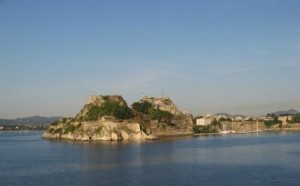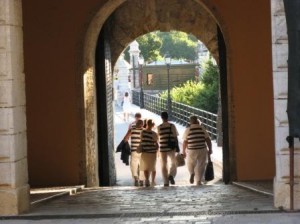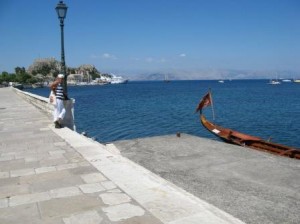
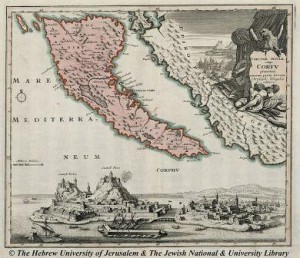
I’m using generic terms, though, because it was sort of a generic experience. We’ve been to Greece with the boat for other events, so I have some means of comparison.
The basic outline was to load the boat onto a truck (the truck travels on the ferry with us); we departed at 2:00 PM and arrived in Corfu at 1:30 PM the next day.
Then we unloaded the boat and rowed it to its base camp in a small marina under the flank of the Old Fortress.
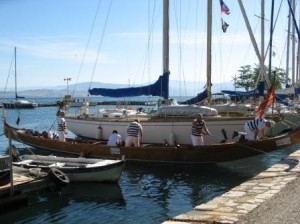
The marina had a good bar, too, with excellent lemonade. These things matter.
The occasion for all this was a long weekend labeled “Italian Days,” a collection of cross-cultural events more or less arranged around the finish of the Brindisi-Corfu yacht race. It was as good a reason as any to choose the second weekend of June.
Apart from the yachts, the program concentrated on the many links binding Venice and Corfu over the centuries — a bond which was
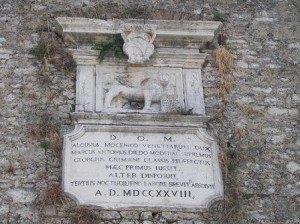
maintained for the almost 500 years in which Venice essentially owned the island. A few links that weren’t acknowledged much were the commercial, political, and military ones, which only left Links Lite such as literature and art. (By “commercial link” I mean things like the fact that most of the 3 million olive trees on the island were planted by the Venetians, whose interest obviously was not landscape gardening but the olives and their oil.) There were also lectures and concerts and exhibitions and so on.

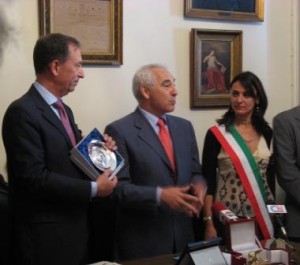
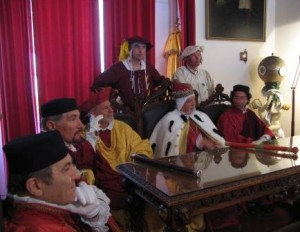
The scene was completed by a contingent of “figuranti,” or historic-costume/re-enactors from the “Serenisimo Tribunal de l’Inquisithion,” the Venice chapter of an organization known as CERS, the Consortium of European Re-enactment Societies. Among the various characters represented with great accuracy is, naturally, a doge. The doge in this group is a great guy, he’s a retired fire chief. Bedecked in all his regalia, he has a way of appearing both imposing and ingratiating, not an easy trick and something I doubt any real doge ever tried.
Our boat was probably the most Venetian element of all, especially considering how much pounding she’s taken and how little maintenance she’s ever been given. Being pounded and neglected being two of the primary aspects of Venice today, I mean.
Our job was to be at the prescribed place at the prescribed hours to offer free boat rides to anybody who wanted to be rowed in a gondola (even a big one) for a few minutes.
Here’s my quick scorecard:
The plus side:
- The trip on the overnight Minoan Lines ferry from Venice to Corfu. Leaving Venice on a ship — in fact, going anywhere on a ship — is the best. It was fun the first time because it was strange and new; it was fun the seventh time because it was familiar.
- Hanging out with my friends, a very eccentric bunch with curious bits of personality flapping around like untied shoelaces. In the un-eccentric contingent I place His Excellency Giampaolo Scarante, the Italian Ambassador to Greece, and his effervescent wife, Barbara, who are two total mensches and our guardian angels. It’s due to them that we are invited to join these frolics.
- Being in Greece. It’s never bad. It’s impossible for it to be bad. Greece, however touristic it may have become, never disappoints me. On the contrary.
- The sun. I love the sun and this is one sun that means what it says. You walk out the front door and you feel like you’ve just been thrown face-down on a skillet. I like this for short periods; then what I really like is sitting in the shade sipping a frappe, or iced coffee. The cafe offered us little ice-cream bonbons, too, which was a novelty — perfect in the heat, but only if you ate them within 18 seconds of their arrival. Which was not a problem for me.
- The food. I love Greek food, though some of my Venetian cohorts reserved judgment (mostly) because many of them are unapologetic food fascists who think the only fodder worth ingesting is Italian.
- The rowing, what little of it we ever eventually got to do. The wind in the afternoon made the return to base camp extremely diverting, not to mention the waves from the many passing ferries and hovercraft.
- Seeing the Venetian fortresses, the Old and the New. Both are stupendous constructions, which resist admiring adjectives as effectively as every missile the Turks hurled at them in three failed sieges.
The Old Fortress, on the site of a Byzantine fort, was built, enlarged, and re-fortified between the 13th and 16th centuries. It now provides office and other space for various departments of the city government, as well as for the University of the Ionian. We had to pass through the Old Fortress four times a day and it just got more amazing each time, not to mention rounding the very point of the peninsula where the fort looms in order to get to our rendezvous point. If nothing else, looking at the fort from whatever distance or perspective made you realize in a visceral way how important Corfu was to the Venetian Republic, and how seriously the Venetians intended that the island should not fall into Ottoman hands, which would have been the End of Everything. And they succeeded. I know they were bandits but they really got the job done.
The crew, having clocked out, leaves the Old Fortress.
The minus side:
- Lack of customers. Unfortunately, the heat, lack of publicity, and disastrous location of our boat worked against the hoped-for mass of passengers. The few that wandered past were more or less like stragglers from the Retreat from Caporetto.
- Our hours, which were 10-1 and 5-8. Looks good on paper, but not so good when you’re tied up next to an esplanade that qualifies as the concrete equivalent of the Nefud Desert, the one Lawrence of Arabia had to cross at night, otherwise they’d all have died. 8-10 AM would have been perfect, as far as the climate is concerned, because the early morning is heavenly, but no Greek (or tourist) in his right, or even totally deranged, mind, would ever be up at that hour. So our window of opportunity was really from 10-10:15. Of course we were good soldiers and waited, till even we couldn’t take it anymore. Ditto the afternoon. After about 6:30 a person can begin to imagine going out on the water, but by then we had lost whatever desire to perform that we might have had, and any potential passengers were thinking of showers, drinks and dinner.
- In the organizers’ defense, however, I can’t think of any other embarkation point that would have been even slightly feasible. So there you are.
Lino thinking Corfiote thoughts, in the center of the Sun's Anvil. The Old Fortress makes a nice touch. - Dinner. Not the food, which was fine, organized in restaurants which had set out long tables for our contingent, the figuranti, the assorted politicos and their assorted consorts who had tagged along, etc. etc. The problem was the hour, which was usually toward 10 PM, which meant finishing toward 1:00 AM. This is a stretch of time which God intended for sleeping, not eating. Or if eating, not to be followed immediately by sleeping, which some of us were on the verge of even as our jaws continued to grind. Hard on the old internals.
But now we’re back, and I’m sorry it didn’t last longer. Of course I would do it all again tomorrow.

